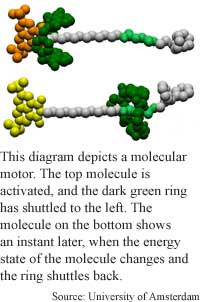
Light
powers molecular piston
By
Kimberly Patch,
Technology Research NewsA group of scientists from three different countries have coaxed a molecule to act like a piston powered by light. This molecular motor could eventually power microscopic machines.
The tiny motor is made of a rotaxane molecule, which consists of a long, threadlike portion, a bead-like macrocyclic that slides along the thread, and thicker parts at each end of the thread that prevent the macrocyclic from sliding off.
The macrocyclic is attracted to whichever end of the thread offers a better binding site. The researchers made the molecule work like a piston by changing the binding sites on the ends of the thread, making first one, then the other attractive to the macrocyclic.
The researchers used light to change the binding sites, effectively powering the piston by light.
"The molecule is extremely simple compared to most other linear or rotary motors. It is... based on hydrogen bonding interactions... and does not consume any chemical auxiliaries, only light," said Fred Brouwer, a senior lecturer of physical-organic chemistry at the University of Amsterdam.
The amount of work the two-nanometer-long molecule produces relative to its size is impressive. One gram of the molecules cycling back and forth 10,000 times per second could theoretically deliver about 500 kilowatts, or about five to times the production of a car engine, according to Brouwer.
Photons of light power the shuttle by creating a negative charge on the end of the molecule that contains a naphthalimide atom group. The negatively charged atom then takes an electron from a donor molecule present in the solution around the molecule.
When the naphthalimide atom group gains the extra electron, the macrocyclic is attracted to the other end of the molecule. After about 100 microseconds, the naphthalimide atom group loses the electron when the donor molecule takes it back, which attracts the macrocyclic bead back to the naphthalimide end of the thread. "Work is performed based on the binding energy gained," said Brouwer.
The research is an important contribution to the nanotechnology field, said Joseph Lyding, professor of electrical and computer engineering at the University of Illinois. "It is a good molecule for a molecular shuttle, both in terms of the ability to characterize the shuttle in process and in the flexibility of modifying its chemical details to tune the shuttling process," he said.
There are many eventual applications for such a shuttle, Lyding said. "Harnessing mechanical motion at the molecular level triggers the imagination about potential applications in biomedicine and in nanotechnology in general," he said.
Eventually, molecular motors like these could be used as "actuators, assemblers and drivers for injectable chembots that might target diseases [and] tumors or repair joints," said Lyding, adding that molecular nanotechnology is still in its infancy.
The piston could also be used in future nanomachines. "One could graft other molecules to the rotating macrocyclic shuttle and then drive a whole variety of reactions or mechanical transformations [in a way] analogous to attaching different kinds of drill bits onto a lathe cylinder," said Steven Kornguth, assistant director of the Institute for Advanced Technology at the University of Texas.
The researchers are currently looking at related molecules with different charge distributions and different structures, said Brouwer. "Also we are investigating chemically different approaches... in which the motion in the two directions can be controlled separately," he said.
The ability to move molecular size objects in relation to each other may also eventually prove useful in a "kind of chemistry-based information processing... in which movement has the function of connecting or disconnecting molecular interactions," said Brouwer. "The obvious source of inspiration here is the brain," he added.
The researchers are working toward harnessing the molecules for practical work. "The real challenge is to put the system to work in an organized environment. We plan to try attachment to a well-defined surface [and] incorporation in a membrane," Brower said.
Brouwer's research colleagues were Celine Frochot and George W. H. Wurpel of the University of Amsterdam, Francesco G. Gatti and David A. Leigh of the University of Warwick in England, and Loic Mottier, Francesco Paolucci and Sergio Roffina of the University of Bologna in Italy.
They published the research in the March 16, 2001 issue of the journal Science. The research was funded by the Universities of Amsterdam, Warwick and Bologna, the European Community and the Netherlands Organization for Scientific Research.
Timeline: > 2 years
Funding: Government, University
TRN Categories: Semiconductors and Materials; Nanotechnology
Story Type: News
Related Elements: Technical paper, "Photo Induction of Fast, Reversible Translational Motion in a Hydrogen-Bonding Molecular Shuttle," Science, March 16, 2001.
Advertisements:
April 18, 2001
Page One
Defects boost disc capacity
Alternative quantum bits go natural
Light powers molecular piston
Bumps could make better biochips
Crystal changes shape in ultraviolet light

News:
Research News Roundup
Research Watch blog
Features:
View from the High Ground Q&A
How It Works
RSS Feeds:
News
Ad links:
Buy an ad link
| Advertisements:
|
 |
Ad links: Clear History
Buy an ad link
|
TRN
Newswire and Headline Feeds for Web sites
|
© Copyright Technology Research News, LLC 2000-2006. All rights reserved.